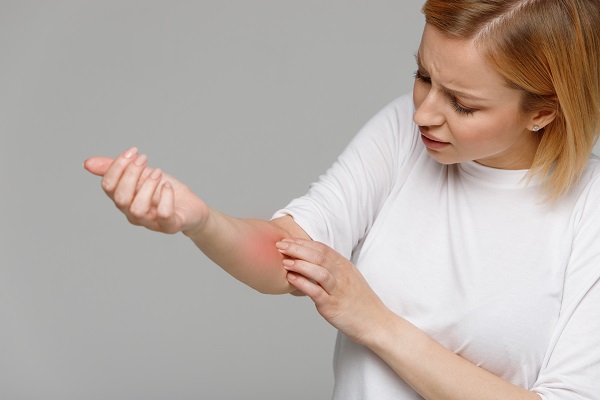Dermatitis and eczema are umbrella terms used to describe a wide range of specific skin health concerns that typically involve itchy, flaky, inflamed, or irritated skin, and many people are unsure of the difference between two of the most common types of eczema, atopic and seborrheic dermatitis. According to Dr. Arathi Rana of U.S. Dermatology Partners in Sherman and Paris, Texas, “One of the most interesting things about dermatitis is that research doctors don’t really know the root cause or underlying condition that creates the symptoms of different forms of dermatitis. The working theory is that atopic dermatitis, seborrheic dermatitis, and other types of eczema all share a common cause that impacts people differently. For this reason, we differentiate between the different forms of dermatitis based on their symptoms.” Learn more about the differences between atopic dermatitis and seborrheic dermatitis in our blog, and don’t hesitate to reach out to Dr. Rana and the U.S. Dermatology Partners team to learn more.
What is Atopic Dermatitis?
Atopic dermatitis is also called eczema. It’s a skin condition that impacts millions of people. This chronic skin condition typically develops in childhood, and people will experience flare-ups in eczema symptoms throughout their lives. The underlying cause of atopic dermatitis is unclear, but whatever triggers the condition, the result is an overactive or disordered immune response that leads to excessive inflammation in the skin.
Atopic Dermatitis Symptoms
While atopic dermatitis can develop on just about any part of the body, symptoms most often affect the face, hands, feet, elbows, and knees. People can have a whole range of symptoms that vary between individuals. Some of the most common symptoms of atopic dermatitis include:
- Itching
- Painful or irritated skin
- Rashes that may ooze or weep fluid
- Dry, flaky, or cracked skin
- Discolored or reddened skin
- Thick or hardened skin patches called plaques
- Poor sleep due to skin itching and irritation
Atopic Dermatitis Causes
While the specific underlying cause of atopic dermatitis is unknown, many factors can contribute to the development of this condition. In many cases, individuals who struggle with eczema have a genetic irregularity that causes insufficient amounts of filaggrin protein to develop. Filaggrin is necessary to ensure the outer layer of skin stays healthy and provides protection to the body. Without adequate levels of filaggrin, a person may be at greater risk for bacterial infection, allergic reactions, dry skin, atopic dermatitis, and a wide range of other skin and whole-body health concerns.
In addition to possible genetic differences and triggers like irritating fabrics, chemicals and perfumes in skincare and hygiene products, foods, and weather changes, some characteristics put people at higher risk for atopic dermatitis, including:
- Having severe allergies or hay fever
- Having asthma
- Having a family history of allergies, hay fever, or asthma
- Being exposed to dust mites or other allergens
Treatment for Atopic Dermatitis
In most cases, atopic dermatitis is a condition that needs to be managed throughout a patient’s life. There is no cure for this condition, but with proper daily care, most people can prevent or reduce the severity of eczema flare-ups. According to Dr. Rana, “Identifying individual triggers that lead to eczema flare-ups and taking steps to avoid these triggers is always the first step to manage atopic dermatitis. From there, I partner with patients to find the right combination of products and treatments to help them maintain their skin health.”
To prevent atopic dermatitis flare-ups and keep skin healthier, patients may take a number of skincare steps, including:
- Take short showers with lukewarm water to avoid stripping moisture from the skin.
- Use gentle cleansers without fragrance to avoid irritating skin.
- Apply moisturizer immediately after bathing or showering.
- Get plenty of sleep, avoid unnecessary stress, and manage any stress that does arise.
- Eat a healthy and nutrient-rich diet.
- Drink plenty of water and keep skin hydrated from the inside out.
In addition to taking steps to prevent flare-ups, your dermatologist can also help you find medications and skin care products that address the symptoms of atopic dermatitis. Some common treatments used during eczema flare-ups include:
- Topical corticosteroids creams and non-steroidal topical ointments
- Biologic medications
- Antibiotics to address possible infections from damaged skin
- Light therapy
What is Seborrheic Dermatitis?
Seborrheic dermatitis is another chronic type of eczema. It takes its name from the body’s oil-producing sebaceous glands, and symptoms of this condition typically develop in areas around sebaceous glands and hair follicles like the scalp, eyebrows, groin, chest, back, and nose.
Seborrheic Dermatitis Symptoms
In infants, seborrheic dermatitis almost always develops on the scalp, leading to dandruff-like flakes. This condition is so common, it has its own name, cradle cap. In some cases, infants also have seborrheic dermatitis symptoms on their bottoms, which can be mistaken for diaper rash, which is actually another type of eczema – contact dermatitis. In adults, symptoms can vary, and they may include:
- Skin redness, swelling, or inflammation
- Greasy scales of skin that may flake or develop into thick plaques
- Rash or itchiness in the affected area
Seborrheic Dermatitis Causes
Just like atopic dermatitis, there’s no known cause for seborrheic dermatitis. However, some factors make individuals more likely to develop this condition, including:
- Age – This type of dermatitis most often impacts infants and adults between the ages of 30 and 60
- Gender – Men are much more likely to develop this condition than women
- History – Individuals who had cradle cap and those who have a family history of seborrheic dermatitis tend to be more likely to develop this condition
- Inflammatory response – A specific type of yeast on the skin may cause skin inflammation and immune system reaction
- Medical diagnoses – Psoriasis, HIV/AIDS, Parkinson’s disease, epilepsy, and recovery from a heart attack or stroke may all increase the risk of developing seborrheic dermatitis
In addition to these risk factors, certain environmental triggers may lead to a flare-up in this skin condition, including stress, hormone shifts, change in weather, and exposure to chemicals.
Treatment for Seborrheic Dermatitis
For infants, using moisturizers and emollients to gently remove the plaques on the scalp and encourage healthy skin growth is usually all that’s needed to achieve complete recovery from this condition. In most cases, infants who recover from cradle cap won’t develop this condition again. In adults, treating seborrheic dermatitis includes a combination of preventive care and treating symptoms as they arise. Some steps patients with seborrheic dermatitis can take to prevent flare-ups include:
- Cleaning affected areas with a gentle cleanser each day
- Use a cleanser with zinc to help prevent inflammation and irritation and protect skin
- Apply a moisturizer directly after washing
- Eat a healthy, nutrient-rich diet
- Get plenty of sleep
- Manage stress
During a flare-up, you may need to develop a treatment plan to address symptoms like itching, inflammation, and redness and remove scales. In most cases, topical antifungal creams and/or shampoos are used to remove the yeast and fungus that can trigger a seborrheic dermatitis flare-up. Using these antifungals periodically can address symptoms of seborrheic dermatitis and help to prevent flare-ups before they start. To address the itch and redness, a topical corticosteroid or calcineurin inhibitor may be used.
Visit U.S. Dermatology Partners
If you’re struggling with atopic or seborrheic dermatitis, the trusted dermatologists at U.S. Dermatology Partners are here to help. You can get started scheduling a visit to our office by completing our simple online form. When we hear from you, one of our team members will be back in touch to finalize your appointment details.
Find a location near me
or


